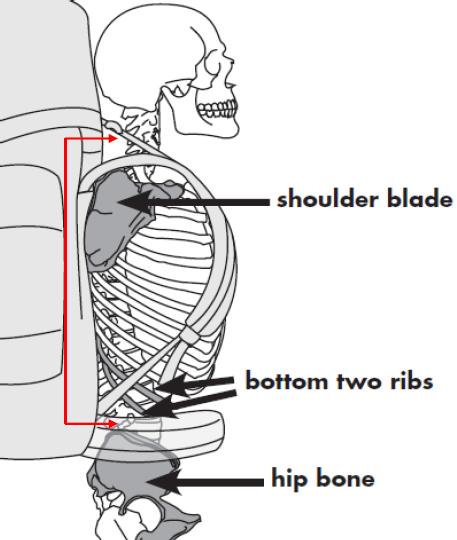While a traditional patrol in a troop is mainly designed for base camp, the scouts of Scout Society have decided to take a different approach.
The patrol method is still used within Scout Society; however to promote scout preparedness and have scouts become self sufficient, the
scouts have decided to become backpacking patrols. In backpacking patrols, the equipment used by the scouts are all packed in a backpacking
backpack. This will allow each scout to be self sufficient as well as always being prepared for events. The information below can be used when
selecting a proper backpack.
Backpacking backpacks are backpacks that allow scouts to pack all their required equipment within the backpack. This would
allow the scouts to travel to the remote wilderness where scouts would not normally be able to go if they used traditional
base camp items. A scout's pack should not weigh more than 30 pounds for a weekend trip. Scouts do not have to buy a name brand
pack if another pack costing half the price can get the job done. According to the Scout Law, a scout is thrifty, so they should
shop around before deciding on an item. Backpacking equipment is an investment, and a good pack that is taken care of can last for a long time.
The section below will provide information on finding the backpack that fits your body structure and trip length.
|
Selecting a Backpacking Backpack
Backpacking backpacks generally fall into two categories: External Frame and Internal Frame. Currently, internal frame packs are
the most common packs that are found. Internal frames are popular compared to the external frame pack, because of how the pack is
designed. An internal frame allows the pack to closely contour with the body. This will enhance the balance of the hiker and is
ideal for mountaineering and hiking in rough terrain. Internal packs also have a narrower profile compared to external frames and
will allow the hiker's arm to be more free and are less prone to pack snag.
While external frames are not as efficient in terms of providing proper balance, they are very efficient at transporting
heavy and bulky loads. External frame backpacking backpacks have a rigid support system on the outside of the pack that
is normally construed of aluminum. This creates a wide profile which can assist in securing bulky objects. External frame,
unlike internal packs, do not contour to the body. This allows external frame packs to provide for better ventilation and allow
more airflow between the hiker and the pack. External frame packs are also cheaper than internal frame packs since they are less complex to assemble when compared
to internal frames. While both packs have their pros and cons, the most important factor is whether the pack you want fits your
body structure.
|
 
 
|
|
Choosing Capacity
The size of a specific backpack is expressed by a number. This number represents the storage room in terms of liters; the higher
the number the larger the volume of the backpack. Some backpacks may even have this number in its name. An example of this is the
Jansport Odyssey 39 where the pack has a volume of 39 liters. The volume of a pack may also be noted in cubic inches. The table
below creates a breakdown between liters and cubic inches:
|
Liters VS Cubic Inches Conversion
| Liters |
Cubic Inches |
| 40 |
2,441 |
| 50 |
3,051 |
| 60 |
3,661 |
| 70 |
4,272 |
| 80 |
4,882 |
| 90 |
5,492 |
|
The volume required for each scout depends mainly on the equipment used and factors such as: how efficient the scout is at storing their
equipment, and the length of the trip. For example a scout going on a week long winter backpacking trip will require a larger
backpack compared to a summer weekend trip. The table below gives a general breakdown of the type of trips and the size of the pack needed.
|
Pack Breakdown
| Pack Type |
Description |
Duration |
Typical Size |
| Day Packs |
Packs intended to be used for daily activities such as day hikes and base camps.
These are backpacks that have shoulder straps but do not have a hip belt. |
1 Day |
Less than 40 liters |
| Multiday Packs |
Packs that are generally suitable for trips ranging from 2 to 4 days. These packs are
larger than the day packs are have both shoulder straps and a hip belt. |
2 to 4 days |
40 - 65 liters |
| Extended Packs |
Packs that are suitable for long trips or scouts that would like to bring more gear. These packs are
designed with a stronger frame and are larger than the packs mentioned above. |
5+ days |
65+ liters |
|
As noted above, the table lists a general guideline on the size of a pack compared to a specific trip.
These are guidelines and will vary depending on each scout. As the scout participates in more outings,
the scout may be able to modify their pack and store their equipment more efficiently, thus requiring a smaller pack.
|
Fitting the Pack
When the scout has decided a backpacking type and the size of the pack, the scout needs to ensure that the pack they selected fits.
The fitting process is broken up into two sections: determining the torso length and determining the waist size. To determine a
scout's torso length, measure the distance between the C7 vertebra (7th cervical vertebra) and the "shelf" of the pelvic girdle.
The C7 vertebra can be found when the scout tilts their head forward and locate the bump on the upper spine. The red arrows in the image
below illustrates the torso length.
|

|
|
Once the torso length has been found, check the specification of the pack to see if you fit.
Some packs come in multiple sizes or can be adjusted to fit the scout's torso. The table below
is a general breakdown of torso size to pack size.
|
Pack Size Breakdown
| Pack Size |
Torso Length |
| Extra Small |
Up to 15-1/2 inches tall (39 cm) |
| Small |
16 - 17 1/2 inches tall (40 - 45 cm) |
| Medium |
18 - 19 1/2 inches tall (46 - 50 cm) |
| Large (Tall) |
20 inches and up (51 cm and up) |
|
A backpacking backpack is heavier than a regular day pack. When correctly setup, the hip belt
should support approximately 80% to 90% of the pack's weight. The hip belt is designed to transfer
most of the backpack's weight directly to the hip so stress is not placed on the shoulder. When correctly
secured, the hip belt should have at least a one inch margin on each side of the belt buckle. If this is
not the case, another backpack should be selected or the hip belt changed.
|
Other Considerations
Backpacking trips can be difficult and having the proper gear can make a world of difference. One important
thought to keep in mind is to ensure that the pack you have chosen feels good on you. Remember, backpacking
trips can range from 10 miles to 50 or more miles. If it doesn't feel good on your back at the store, chances
are that it will feel worst after filling the pack and hiking 15 miles. Knowing your torso and waist size will
help in selecting a backpack that fits you. There are other considerations while you are looking for the pack that fits you:
|
- Ventilation - Depending on the season that you will be hiking in, ventilation can play an important role when selecting a
pack. While internal frames are designed to be less bulky, the main drawback of the pack is that ventilation is restricted.
Newer packs address this problem by designing a ventilation channel in the back to increase airflow. If your heart is set on an
internal pack but also want good ventilation, shop around to see if you can locate one of these packs.
- Hydration - Hydration packs have made bottles a thing of the past . . . almost. While water bottles are still an important
item to bring for filtration and water storage, many hikers have changed to hydration packs which can hydrate the hiker without
the need to take out a bottle. Many newer packs have hydration capability which has an area for the hydration reservoir as well
as an opening for the sip tube to come out. This may also be a factor when deciding which pack to choose.
- Material - Weight versus durability is another thing to keep in mind. Depending on the pack, backpacking backpacks are
constructed with different materials. Some manufactures may use a thinner material to reduce weight. While others may user a thicker
material to prolong the life of the gear. The thing to keep in mind is to have a balance between weight and durability.
|
While these items are not as important, it will definitely help in making your outdoor experience a good one. Finding a pack that
properly fits is the difference between having a great trip or a trip that you wished you have never started on. Backpacking
gear is an investment and if it is taken care of properly, it will last for years to come. Happy trails!
|
















